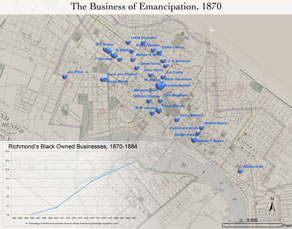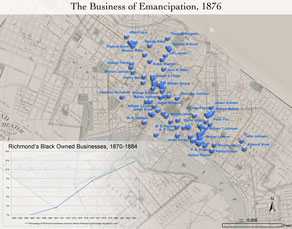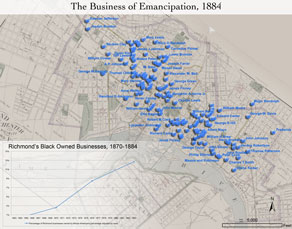Visualizing the Richmond Slave Trade
Eight years after his tour of Richmond, Crowe used his sketch from that day as the basis for his painting Slaves Waiting for Sale, Richmond, Virginia. Crowe's painting during the Civil War was a political intervention. In mid-nineteenth-century British art, people of African descent were generally not the subjects of fine art; in fact, they were deemed unsuitable subjects. As one critic of Crowe's paintings put it, African Americans "do not commend themselves either to the eye or to the mind. Neither the colour nor the features of the negro race can be associated with European notions of aesthetic beauty." In contrast, depictions of African Americans were ubiquitous in graphic art, and in such depictions in both Britain and the U.S. African Americans, particularly those of darker complexion, were presented as exaggerated racial caricatures, as comical figures to be laughed at. Subjects that were politically controversial or ignoble were also beyond the pale of fine art--subjects like slavery and the slave trade.iv

In his painting Crowe challenged both the conventional boundaries of "fine art" and the conventional portrayals of African Americans. In Slaves Waiting for Sale African Americans, slavery, and the slave trade were made the subjects of "fine art," and Africans Americans were represented in ways that conveyed, for the most part, dignity and emotional depth. Notice, for example, the figure sitting apart, to the far right of the painting. Here was no racialized stereotype-instead Crowe offered an intensely displeased man, brooding on his fate. This tableau was meant to evoke from its audience not dismissive laughter but rather some measure of empathetic identification across the division of race, the division of nation, and the division separating free from enslaved.
This political intervention composed a representational space-one reflective of its social structure in London of the 1860s, a devastating critique of U.S. slavery that was at the same time far removed from the U.S. domestic institution. Black Virginians by and large did not see this painting. Instead, they inhabited and produced the spaces Crowe had imaginatively represented in his art.
According to Lefebvre, "New social relationships call for a new space." If slavery had been integral, not just to the state's economy, but to its material infrastructure, then how did these places change when slavery disappeared? In Richmond, anyway, African Americans built an entire class of institutions that could not have existed under slavery.v

In place of jails, they built schools-I'm thinking of Robert Lumpkin's jail complex. Lumpkin ran a profitable jail for enslaved men and women awaiting sale. His business was indispensible, since the slave trade was not so efficient that it did not require some warehousing of people-chattel. Lumpkin died as the Civil War came to a close, and by 1867, his widow Mary, whom he had held as a slave and with whom he lived openly, leased the buildings to missionaries who quickly began a school. A former student of the institution, which eventually became Virginia Union University, aptly described the transformation in space, in words now well known to locals, "from the devil's half-acre to God's half-acre."vi
Other changes were less dramatic but more maybe just as interesting, if only because they hint that the transformation of urban space was more than a single plot of land. Perhaps largest building in Richmond, the African Church had three thousand members. In 1865, when Union troops occupied the city, soldiers enlisted among the United States Colored Troops denied the white, pro-slavery former pastor of the church entrance to the church. Soon the congregation installed a white abolitionist as their preacher, whose short tenure was followed quickly by an African American pastor.vii Black businesses, too, found tremendous success in the increasingly segregated New South. Five years after the end of slavery, fifty black businessmen and women were listed in the city directory. By 1876, as national Reconstruction came to a close, the number had quadrupled. Seven years later, 376 black-owned businesses were named in the directory.viii
- iv"British Artists: Their Style and Character. With Engraved Illustrations. No. LXXIII. Eyre Crowe," The Art Journal 26 (1864): 207. [back]
- vLefebvre, 59. [back]
- viMatthew Laird, James River Institute for Archaeology, "Preliminary Archaeological Investigation of the Lumpkin's Jail Site, Richmond, Virginia" (May 2006). See also Charles H. Corey, A History of the Richmond Theological Seminary with Reminiscences of Thirty Years' Work among the Colored People of the South (J.W. Randolph Co., Richmond, 1895) 46-77 and Charles Emery Stevens, Anthony Burns: A History (electronic edition, University of North Carolina at Chapel Hill, DocSouth Collection; originally published 1856) 187-94. [back]
- viiCharles F. Irons, "And All These Things Shall Be Added Unto You: the First Baptist Church, Richmond, 1841-1865," Virginia Cavalcade, 47 (Winter 1998): 26-35. [back]
- viiiHill's Richmond City Directory, (Richmond: John Maddox, et al., 1870); Sheriff & Co.'s Richmond City Directory (Richmond: Sheriff & Co., 1876); and Chataigne's Richmond Directory, (Richmond: J. H. Chataigne, 1884). University of Richmond undergraduates Nadia Bukach, Megan Bersani, and Lauren Gallagher gathered much of this data. Nadia Bukach recently explored these transformations in "Richmond's Black Businesses: Geographies of Race in a Southern Post-Civil War City," a paper presented at the American Association of Geographers annual meeting, Washington, DC, April 2010. [back]


